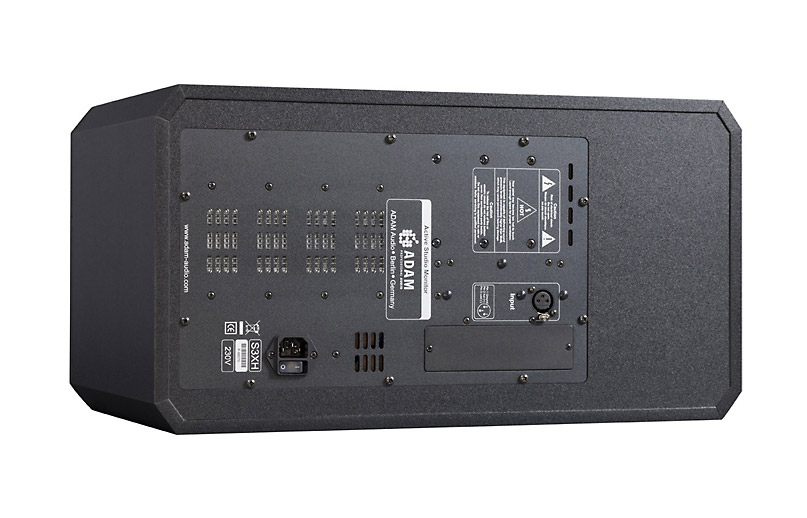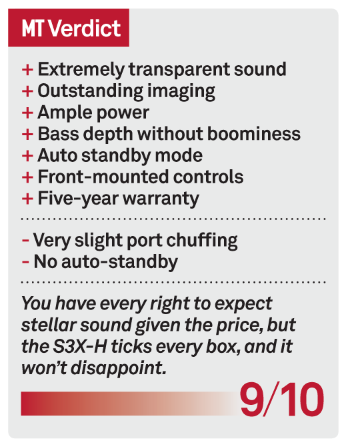Adam S3X-H Review
The S3X-H active midfield/nearfield monitor is Adam’s attempt to deliver high power with no loss of accuracy or transparency. Huw Price thinks it’s succeeded… Details Price £2,000 each Manufacturer Adam Contact 07590 069007 or 0207 737 3777 Web www.Adam-audio.com Although the original Adam S3A was well received by recordists working with acoustic instruments, the dance […]

The S3X-H active midfield/nearfield monitor is Adam’s attempt to deliver high power with no loss of accuracy or transparency. Huw Price thinks it’s succeeded…


Details
Price £2,000 each
Manufacturer Adam
Contact 07590 069007 or 0207 737 3777
Web www.Adam-audio.com
Although the original Adam S3A was well received by recordists working with acoustic instruments, the dance guys weren’t convinced there was enough low-end power to cope with synths and sample-based drum and bass sounds.
So the design brief for the S3X-H was to provide the power without sacrificing the accuracy. The original driver complement comprised two 7.5-inch woofers and a tweeter.
One woofer handled bass frequencies below 150Hz, with the other filling the gap up to the 1.8kHz crossover point with the tweeter. Adam’s design for the S3X-H sees the addition of a dedicated 4.5-inch midrange driver. This allows for a higher crossover frequency with the tweeter, and both the woofers are used to drive the same frequency band. For good measure, Adam made the cabinet walls thicker, too.
Creamy Cones
Adam’s bass and midrange drivers are made from HexaCone. This is described as “an aramid-plastic core with honeycomb structure coated on both sides with Kevlar”.
The intention is to achieve maximum strength and stiffness while minimising weight for fast dynamic response and resonance frequencies that are outside the audible range.
The X-ART tweeter is inextricably linked to Adam monitors. ART stands for Accelerated Ribbon Technology, and it’s based on an ‘Air Motion Transformer’, invented by Dr. Oskar Heil back in 1972. Instead of a metal ribbon, it employs a folded diaphragm that squeezes air in and out in response to an AC current. This apparently offers much greater efficiency over a standard piston driver, and a faster response time for improved transients.
The onboard power ampspecs are pretty daunting. For the tweeter, Adam developed a low-noise 50-watt amplifier with a claimed flat frequency response reaching up to 300kHz. A 250-watt PWM amplifier feeds each of the woofers, and this amplifier is used in all the SX-Series monitors. Lastly, a further 250-watt amplifier is used for the midrange driver, which totals up to 800 watts of onboard power.
Some of us will have gigged with less powerful PA systems.
Regular readers may know that we often grumble about rear-mounted power switches. Although the main power switch is round the back, Adam has provided a standby switch on the front, along with extensive level and frequency adjustment controls – see the boxout over for more details.
In Use Tip
Adam’s method of mounting the controls on the front panel is absolutely the best way to do it. The controls include Input Sensitivity, with ‘coarse’ 4dB steps from -20 to +8dB and fine 0.5dB steps between -1.5 and +2dB.
You can adjust the 80Hz response from 0 to +6dB in 1dB steps, and there’s low shelving at 150Hz in 1dB steps. As well as high shelving above 6kHz (±4dB in 1dB steps), there’s a tweeter gain control, providing ±2dB in 0.5dB steps. The control panel also has two LEDs to indicate clipping and the status of the optional D/A-converter.

On the Wall
The S3X-H also has some interesting options. Given the size and midfield capabilities, this speaker could be soffit mounted. To facilitate this, the S3X, along with the S2X, S4X and S5X, can be purchased as a passive unit, to be used with Adam’s external amplification system – EA-SX. The amplifiers are housed in a 19-inch rack enclosure with a front-mounted control. An optional 24-bit/192kHz DAC plug-in card is also available for SX models (S2X and higher).
Most monitors these days come with set-up guides in the instructions. Although the S3X-H is very much at the upper end of the monitor market, Adam nevertheless obliges. Once we had ensured the tweeters were at ear level and we had constructed our stereo triangle, the key was toeing in the angle of the speakers to achieve rock-solid centre images without congestion or restricted soundstage.
Widescreen
We’re mentioning this because after taking our time over setting up, it was immediately apparent that the S3X-H produces an unusually wide and spacious stereo image. Central images are rock-solid, but panned instruments appear over a broader expanse, in order to create a sound that’s very much open and uncluttered.
We have noticed port chuffing with Adam monitors before – and the S3X-H does it, too. However, under normal listening conditions it’s undetectable and occurs only in the 35Hz-45Hz region – give or take a few Hertz – and then only when the test tone is blasted through the box at high levels that wouldn’t be tolerable under normal working conditions.
The uninitiated may feel that the S3X-H isn’t especially bassy, but don’t let the absence of a low-mid hump fool you, because these things really pump out the lows with authority. The bass response reaches way down but sounds even and well controlled, plus it has effortless speed and slam to articulate the transients of kick drums and bass notes. Things are similarly extended at the other frequency extreme, courtesy of Adam’s characteristic folded ribbon tweeter.
In our experience, the positive aspects of this design are that you don’t have to struggle to hear what’s happening with hats, cymbals and so forth – and they don’t make your ears tired.
However, one potential pitfall is the way they make it almost too easy to achieve mixes with airy trebles, because those same mixes can sound dull on other speaker systems. To avoid this issue, we ran the S3X-H with tweeter response slightly attenuated, which provided better consistency when switching back and forth with our other reference monitors. Other than that, we felt perfectly happy working with flat settings.

Alternatives
The Focal SM9 (£2,150 each) has an innovative ‘two monitor speakers in one cabinet’ approach. One side combines a Beryllium tweeter and 6.5-inch “W” woofer, and on the other there’s an 8-inch subwoofer with an 11-inch passive radiator.
What’s cool is you can switch the woofer and radiator off. Barefoot Sound’s MicroMain 45 (£4,999 pair) is a stripped-down, three–way version of the flagship MiniMain 12, with three drivers and ample onboard amplification. The Quested V3110 (£2,292 each) is an active midfield three-way with a dedicated midrange driver.
Mid Magic
The issue with many monitors that emphasise the top and bottom ends of the frequency spectrum is a slightly hollow and recessed midrange. This probably occurs because the tweeter is expected to go too low and the woofer too high.
There’s no trace of this midrange issue with the S3X-H, probably because the dedicated midrange driver allows the tweeter and woofer to do what they do best. During the time we had the S3X-H, we were in the midst of a pile of editing and mixing work. Having the Adams proved fortuitous, because they provided so much information regarding the stereo imaging and that all-important relationship between the kick drum
and bass.
As well as presenting mixes in an open and coherent way, the S3X-H allows you to zone in on specific instruments and frequency bands.
As you carry out equalisation and compressor adjustments to make mix elements gel and interact, it’s easy to hear the effect of small changes and their effect on the whole.
Ultimately, these Adams deliver the forensic detail, imaging accuracy, transient response, wide frequency range and flexibility needed for top-end professional monitoring. They’re also commendably quiet, considering the sheer power of the amplifiers, and they can go extremely loud – but, most importantly, they’re very enjoyable to listen to.

Key Features
● 2x 7.5” HexaCone bass woofers
● 1x 4.5” HexaCone midrange driver
● 1x X-ART tweeter
● 3x 250W RMS PWM amplifiers
● 1x 50W RMS high-frequency amplifier
● Input Sensitivity control
● 80Hz adjustment -0 to +6 dB (1dB steps)
● High Shelf EQ > 6kHz ±4dB (1dB steps)
● Low Shelf EQ < 150Hz ±4dB (1dB steps) ● Tweeter gain ±2dB (0.5 dB steps) ● Analog XLR input ● Frequency response 32Hz-50 kHz ● THD > 80Hz ≤0.6 %
● Max SPL with sine wave acoustic 100Hz to 3kHz at 1m≥116dB
● Max SPL per pair at 1m≥126dB
● Crossover frequencies 350/2800Hz
● Weight 43.2lb (19.6kg)
● Dimensions 280mmx530mm x320 mm


